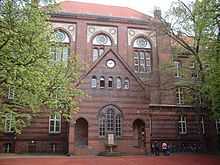Education in Berlin

Education in Berlin covers the whole spectrum from kindergarten, primary education, secondary education, and higher education in Berlin. The German states are primarily responsible for the educational system in Germany.
Primary schools
The State of Berlin has a six-year primary education program.
Secondary education
before 2010/11
After completing primary school, students progressed to one of the four types of secondary schools for up to six further years: Hauptschule, Realschule, Gymnasium, or Gesamtschule. When parents were allowed to choose which of this schools their child applied for the gymnasiums were often heavily oversubscribed and admitted only the students who did the best in primary school.
Reform of Education
Now, there are only two types of schools:
- the Sekundarschule: The Senate of Berlin decided that Hauptschulen, Realschulen and Gesamtschulen should be merged to become the new Sekundarschule. The Sekundarschule will be a comprehensive school and serve students from a wide range of abilities. Depending how well they did in school, students graduating from a Sekundarschule will receive the Hauptschulabschluss, the Realschulabschluss or the Abitur.[1] Class size for the Sekundarschule will be 25 students.[2]
- The Gymnasium (college preparatory school). It was ruled that Berlin's Gymnasien should no longer be allowed to handpick all off their students. It was ruled that while they should be able to pick 65% to 70% of their students, the other places at the Gymnasien are to be allocated by lottery. Every child will be able to enter the lottery, no matter how he or she performed in primary school. It is hoped that this policy will increase the number of working class students attending a Gymnasium.[3] Class size for the Gymnasium will be 32 students.[2]
Abitur
Since the school year 2006/2007, the abitur in German, mathematics and foreign languages has been marked centrally in Berlin, and five examinations have to be taken instead of four. Students starting in grade 7 in that year or later complete the abitur after twelve years.
Schools in Berlin

Notable schools in Berlin include:
- Heinrich-Hertz-Gymnasium Berlin (STEM), Gymnasium
- Französisches Gymnasium Berlin, Gymnasium
- Canisius-Kolleg Berlin, Gymnasium
- Evangelisches Gymnasium zum Grauen Kloster, Gymnasium
- Französisches Gymnasium Berlin, Gymnasium
- John F. Kennedy School, Berlin, primary and secondary school
- Oberschule am Elsengrund, Gymnasium
- Rütli School, Hauptschule
- Nelson Mandela School, secondary school
Universities in Berlin
The city has four universities and numerous private, professional and technical colleges (Fachhochschulen), offering students a wide range of disciplines.[4] Around 130,000 students attend the universities and professional or technical colleges.[5] The three largest universities account for around 100,000 students. These are the Humboldt Universität zu Berlin with 35,000 students, the Freie Universität Berlin (Free University of Berlin) with around 35,000 students, and the Technische Universität Berlin with 30,000 students. The Universität der Künste has about 4,300 students.
References
- ↑ Regina Köhler: "So funktioniert Berlins neue Sekundarschule". Berliner Morgenpost. May 13th 2009
- ↑ 2.0 2.1 http://www.tagesspiegel.de/berlin/familie/schule/Schulreform-Berlin-Sekundarschule-Gymnasium;art295,2820938
- ↑ Heinz-Peter Meidinger: "Berliner Schullotterie". Profil 07-08/2009 (August 24th. 2009)
- ↑ "Metropolis of Sciences". Berlin Partner GmbH. Archived from the original on 2008-04-24. Retrieved 2008-08-19.
- ↑ "Berlin statistical figures". Statistisches Landesamt Berlin. Retrieved 2008-08-19.(German)
| |||||||||||||||||